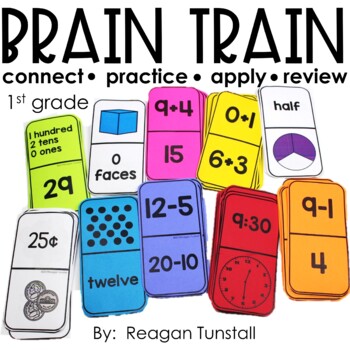Brain Train Math Dominoes First Grade
Reagan Tunstall
106.4k Followers
Grade Levels
1st, Homeschool
Subjects
Resource Type
Standards
CCSS1.NBT.A.1
CCSS1.NBT.B.2
CCSS1.NBT.B.2b
CCSS1.NBT.B.2c
CCSS1.OA.A.1
Formats Included
- PDF
Pages
65 pages
Reagan Tunstall
106.4k Followers
What educators are saying
I used these domino cards as a math station. My students enjoyed them and they did not take a long time to make. Print, laminate and cut.
I use these with independent work for my workshop time. The kids grab a set and try to get them all to connect before time time is up.
Description
Brain Train is a math dominoes review game. This set is targeted for first grade.
Students take turns to connect {match} cards to build brain trains.
There are 10 different math games in this set.
Number Sense
Addition to 10
Subtraction to 10
Addition to 20
Subtraction to 20
Place Value to 120
Time to the hour and half hour
2D and 3D Shapes
Fractions
Coins
Related Products
• Stations by Standard Bundle First Grade
• Digital End of Year Math Review First Grade
Reagan Tunstall
Tunstall's Teaching Tidbits
Total Pages
65 pages
Answer Key
N/A
Teaching Duration
N/A
Report this resource to TPT
Reported resources will be reviewed by our team. Report this resource to let us know if this resource violates TPT’s content guidelines.
Standards
to see state-specific standards (only available in the US).
CCSS1.NBT.A.1
Count to 120, starting at any number less than 120. In this range, read and write numerals and represent a number of objects with a written numeral.
CCSS1.NBT.B.2
Understand that the two digits of a two-digit number represent amounts of tens and ones. Understand the following as special cases:
CCSS1.NBT.B.2b
The numbers from 11 to 19 are composed of a ten and one, two, three, four, five, six, seven, eight, or nine ones.
CCSS1.NBT.B.2c
The numbers 10, 20, 30, 40, 50, 60, 70, 80, 90 refer to one, two, three, four, five, six, seven, eight, or nine tens (and 0 ones).
CCSS1.OA.A.1
Use addition and subtraction within 20 to solve word problems involving situations of adding to, taking from, putting together, taking apart, and comparing, with unknowns in all positions, e.g., by using objects, drawings, and equations with a symbol for the unknown number to represent the problem.





